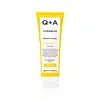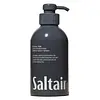What's inside
What's inside
 Key Ingredients
Key Ingredients

 Benefits
Benefits

 Concerns
Concerns

 Ingredients Side-by-side
Ingredients Side-by-side

Water
Skin ConditioningCetearyl Alcohol
EmollientSodium Cocoyl Isethionate
CleansingPrunus Amygdalus Dulcis Oil
Skin ConditioningGlycerin
HumectantXanthan Gum
EmulsifyingCeramide NP
Skin ConditioningSqualane
EmollientAnanas Sativus Fruit Extract
Skin ConditioningSimmondsia Chinensis Seed Oil
EmollientOlive Glycerides
EmulsifyingGlucose
HumectantXylitylglucoside
HumectantAnhydroxylitol
HumectantXylitol
HumectantSodium Stearoyl Glutamate
CleansingSodium Benzoate
MaskingSodium Gluconate
Skin ConditioningCaprylyl Glycol
EmollientPolyacrylate Crosspolymer-6
Emulsion StabilisingCyclodextrin
AbsorbentParfum
MaskingPhenoxyethanol
PreservativeSodium Hydroxide
BufferingHexyl Cinnamal
PerfumingLinalool
PerfumingBenzyl Salicylate
PerfumingWater, Cetearyl Alcohol, Sodium Cocoyl Isethionate, Prunus Amygdalus Dulcis Oil, Glycerin, Xanthan Gum, Ceramide NP, Squalane, Ananas Sativus Fruit Extract, Simmondsia Chinensis Seed Oil, Olive Glycerides, Glucose, Xylitylglucoside, Anhydroxylitol, Xylitol, Sodium Stearoyl Glutamate, Sodium Benzoate, Sodium Gluconate, Caprylyl Glycol, Polyacrylate Crosspolymer-6, Cyclodextrin, Parfum, Phenoxyethanol, Sodium Hydroxide, Hexyl Cinnamal, Linalool, Benzyl Salicylate
Water
Skin ConditioningCocamidopropyl Betaine
CleansingSodium C16 Olefin Sulfonate
EmulsifyingSqualane
EmollientNiacinamide
SmoothingCarapa Guianensis Seed Oil
Skin ConditioningBertholletia Excelsa Seed Oil
EmollientAscorbyl Glucoside
AntioxidantSodium Hyaluronate
HumectantChlorella Vulgaris Extract
Skin ConditioningCandida Bombicola/Glucose/Methyl Rapeseedate Ferment
AntimicrobialSodium PCA
HumectantOlea Europaea Fruit Oil
MaskingHelianthus Annuus Seed Oil
EmollientPropanediol
SolventMagnesium PCA
HumectantArgania Spinosa Kernel Oil
EmollientZinc PCA
HumectantLithospermum Erythrorhizon Root Extract
Skin ConditioningGlycyrrhiza Uralensis Root Extract
Skin ConditioningAngelica Gigas Root Extract
Skin ConditioningManganese PCA
HumectantLactic Acid
BufferingPhenoxyethanol
PreservativePEG-150 Distearate
EmulsifyingSodium Cocoyl Isethionate
CleansingSodium Benzoate
MaskingCitric Acid
BufferingTetrasodium Glutamate Diacetate
Parfum
MaskingLimonene
PerfumingWater, Cocamidopropyl Betaine, Sodium C16 Olefin Sulfonate, Squalane, Niacinamide, Carapa Guianensis Seed Oil, Bertholletia Excelsa Seed Oil, Ascorbyl Glucoside, Sodium Hyaluronate, Chlorella Vulgaris Extract, Candida Bombicola/Glucose/Methyl Rapeseedate Ferment, Sodium PCA, Olea Europaea Fruit Oil, Helianthus Annuus Seed Oil, Propanediol, Magnesium PCA, Argania Spinosa Kernel Oil, Zinc PCA, Lithospermum Erythrorhizon Root Extract, Glycyrrhiza Uralensis Root Extract, Angelica Gigas Root Extract, Manganese PCA, Lactic Acid, Phenoxyethanol, PEG-150 Distearate, Sodium Cocoyl Isethionate, Sodium Benzoate, Citric Acid, Tetrasodium Glutamate Diacetate, Parfum, Limonene
 Reviews
Reviews

Ingredients Explained
These ingredients are found in both products.
Ingredients higher up in an ingredient list are typically present in a larger amount.
Parfum is a catch-all term for an ingredient or more that is used to give a scent to products.
Also called "fragrance", this ingredient can be a blend of hundreds of chemicals or plant oils. This means every product with "fragrance" or "parfum" in the ingredients list is a different mixture.
For instance, Habanolide is a proprietary trade name for a specific aroma chemical. When used as a fragrance ingredient in cosmetics, most aroma chemicals fall under the broad labeling category of “FRAGRANCE” or “PARFUM” according to EU and US regulations.
The term 'parfum' or 'fragrance' is not regulated in many countries. In many cases, it is up to the brand to define this term.
For instance, many brands choose to label themselves as "fragrance-free" because they are not using synthetic fragrances. However, their products may still contain ingredients such as essential oils that are considered a fragrance by INCI standards.
One example is Calendula flower extract. Calendula is an essential oil that still imparts a scent or 'fragrance'.
Depending on the blend, the ingredients in the mixture can cause allergies and sensitivities on the skin. Some ingredients that are known EU allergens include linalool and citronellol.
Parfum can also be used to mask or cover an unpleasant scent.
The bottom line is: not all fragrances/parfum/ingredients are created equally. If you are worried about fragrances, we recommend taking a closer look at an ingredient. And of course, we always recommend speaking with a professional.
Learn more about ParfumPhenoxyethanol is a preservative that has germicide, antimicrobial, and aromatic properties. Studies show that phenoxyethanol can prevent microbial growth. By itself, it has a scent that is similar to that of a rose.
It's often used in formulations along with Caprylyl Glycol to preserve the shelf life of products.
Sodium Benzoate is a preservative. It's used in both cosmetic and food products to inhibit the growth of mold and bacteria. It is typically produced synthetically.
Both the US FDA and EU Health Committee have approved the use of sodium benzoate. In the US, levels of 0.1% (of the total product) are allowed.
Sodium benzoate works as a preservative by inhibiting the growth of bacteria inside of cells. It prevents the cell from fermenting a type of sugar using an enzyme called phosphofructokinase.
It is the salt of benzoic acid. Foods containing sodium benzoate include soda, salad dressings, condiments, fruit juices, wines, and snack foods.
Studies for using ascorbic acid and sodium benzoate in cosmetics are lacking, especially in skincare routines with multiple steps.
We always recommend speaking with a professional, such as a dermatologist, if you have any concerns.
Learn more about Sodium BenzoateSodium cocoyl isethionate is a natural ingredient from coconut oil. It is an ultra gentle cleanser that gives a nice foam without drying the skin or impacting the skin barrier.
The amount of foam created depends on the amount of sodium cocoyl isethionate used in the product.
This ingredient also helps improve the spreadability of a product.
Learn more about Sodium Cocoyl IsethionateSqualane is an emollient that helps the skin hold onto moisture. It's an oily liquid that occurs naturally in certain types of fish and plant oils.
Because squalane boosts hydration in the skin, it also comes with plenty of benefits: it is an antioxidant and can help fight free radicals and skin damage. Squalane is also found to have a detoxifying effect when applied.
Squalane comes from squalene, which occurs naturally within the sebum of our skin. It is one of the oils our skin produces to keep itself hydrated. Squalane is the hydrogenated version of squalene and has a longer shelf life.
Research shows that squalane is non-irritating (even at 100% concentration).
In general, it's a fantastic ingredient. It does a great job at hydrating the skin, and it's suitable for those with sensitive skin.
The source of squalane may impact malassezia / fungal acne. This is because olive oil derived squalane can contain impurities such as fatty acids and plant waxes. Sugarcane derived squalane is recommended for anyone with malassezia concerns.
Is squalane vegan?
This depends on the source. Squalane can be derived from both plants and animals. Most squalane used in skincare comes from plants.
Please note: the source of squalane is only known if disclosed by the brand. We recommend reaching out to the brand if you have any questions about their squalane.
Read more about squalene with an "e".
Is squalane an oil?
Squalane is often called an oil, but it’s technically not; it’s a hydrocarbon, meaning it’s only made of carbon and hydrogen, unlike true oils which are triglycerides made of fatty acids and glycerol.
The term “oil-free” isn’t regulated, so companies can define it however they want. Some exclude all oils, while others just avoid mineral oil or comedogenic oils.
While some people avoid oils thinking they cause breakouts, the right kind of oil (or oil-like ingredient like squalane) can actually help balance and hydrate your skin. It’s worth testing out simple oils or squalane to see what works best for your skin.
Learn more about SqualaneWater. It's the most common cosmetic ingredient of all. You'll usually see it at the top of ingredient lists, meaning that it makes up the largest part of the product.
So why is it so popular? Water most often acts as a solvent - this means that it helps dissolve other ingredients into the formulation.
You'll also recognize water as that liquid we all need to stay alive. If you see this, drink a glass of water. Stay hydrated!
Learn more about Water